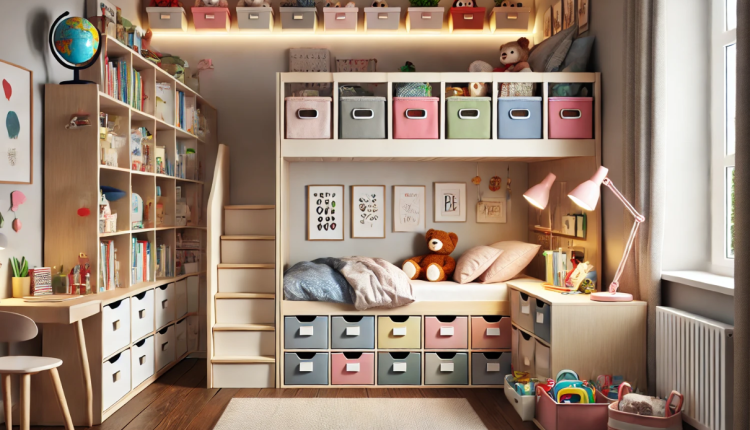Creating a Functional and Organized Children’s Room: A Comprehensive Guide
Designing and maintaining an organized children’s room is a rewarding endeavor that fosters a conducive environment for play, study, and rest. A well-structured space not only enhances a child’s development but also instills a sense of responsibility and orderliness. This guide offers practical strategies to transform your child’s room into a harmonious and efficient haven.
Assessing the Current Space
Before embarking on the organization process, evaluate the existing setup of your child’s room. Consider the following aspects:
- Space Utilization: Identify underutilized areas that can be optimized for storage or activity zones.
- Safety Measures: Ensure that furniture is securely anchored, and hazardous items are out of reach.
- Child’s Preferences: Involve your child in the assessment to understand their needs and preferences, making the space more personalized and functional.
Decluttering: The First Step to Organization
A clutter-free room sets the foundation for effective organization. Begin by:
- Sorting Belongings: Categorize items into keep, donate, and discard piles. Encourage your child to participate, teaching them the value of letting go of unused items.
- Rotating Toys: Store some toys out of sight and rotate them periodically to keep the selection fresh and manageable.
- Managing Sentimental Items: Designate a specific area or box for cherished items, preventing them from contributing to everyday clutter.
Maximizing Vertical Space
Utilizing vertical space can significantly enhance storage capacity:
- Wall-Mounted Shelves: Install shelves to hold books, toys, and decorative items, freeing up floor space.
- Hanging Organizers: Use over-the-door organizers or wall hooks for accessories, bags, and small toys.
- Pegboards: Customize pegboards with hooks and baskets to accommodate various items, offering flexible storage solutions.
Smart Furniture Choices
Investing in multifunctional furniture can optimize space and functionality:
- Loft Beds: Elevate the bed to create space underneath for a desk, play area, or additional storage.
- Beds with Built-In Storage: Choose beds with drawers or trundle options to store bedding, clothes, or toys.
- Foldable Desks and Chairs: These can be stowed away when not in use, freeing up space for other activities.
Effective Storage Solutions
Implementing appropriate storage solutions ensures that every item has its place:
- Clear Bins and Labels: Transparent bins with labels help children easily identify and access their belongings.
- Cubbies and Baskets: Place these at a child-friendly height to encourage independent organization.
- Under-Bed Storage: Utilize this often-overlooked space for storing less frequently used items.
Creating Activity Zones
Designate specific areas within the room for different activities:
- Study Area: A quiet, well-lit corner with a desk and necessary supplies fosters concentration and learning.
- Play Zone: An open space with easy access to toys encourages imaginative play.
- Reading Nook: A cozy spot with comfortable seating and a bookshelf promotes a love for reading.
Personalizing the Space
Incorporate elements that reflect your child’s personality and interests:
- Color Scheme: Use bright, neutral colors as a base and add pops of your child’s favorite colors through accessories and decor.
- Themed Decor: Integrate themes that resonate with your child’s interests, such as animals, space, or fairy tales.
- Display Artwork: Frame and hang your child’s artwork to personalize the space and boost their confidence.
Establishing Organizational Routines
Consistency is key to maintaining an organized room:
- Daily Tidying: Encourage your child to spend a few minutes each day putting things back in their designated places.
- Weekly Cleaning: Set aside time each week for more thorough cleaning and organization.
- Responsibility Chart: Create a chart outlining daily and weekly tasks to instill a sense of accountability.
Safety Considerations
Ensure that the room is a safe environment for your child:
- Secure Furniture: Anchor heavy furniture to the wall to prevent tipping.
- Cord Management: Keep electrical cords out of reach or secured with cord organizers.
- Non-Toxic Materials: Choose furniture and decor made from non-toxic materials to ensure your child’s well-being.
Adapting to Changing Needs
As your child grows, their needs and preferences will evolve:
- Flexible Furniture: Invest in adjustable furniture that can adapt to your child’s changing requirements.
- Regular Assessments: Periodically reassess the room’s setup and make necessary adjustments to accommodate growth and new interests.
- Open Communication: Keep an open dialogue with your child about their needs and involve them in the reorganization process.
Conclusion
Organizing a child’s room is a dynamic process that requires thoughtful planning, creativity, and collaboration. By assessing the current space, decluttering, utilizing smart storage solutions, and establishing routines, you can create a functional and personalized environment that supports your child’s development and fosters a sense of responsibility. Remember, the goal is to create a space that grows with your child, adapting to their evolving needs and interests.

